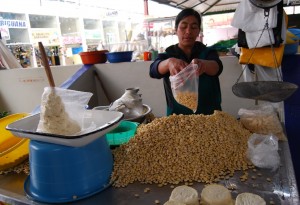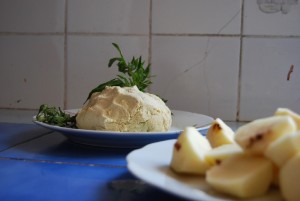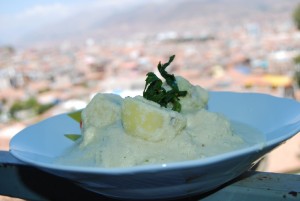Chef’s Sunday: Tarwi as a Main Dish

Tarwi, also called chocho, is a legume that is native to the Andes. It has been used in gastronomy from well before the Incas. While it can accompany other dishes, it finds use on the center stage, as a main dish, in this characteristic Andean meal.
It is a traditional dish from the city of Cuzco that is loved by Cuzco’s families. Besides having high nutritional value given its rich array of proteins, when combined with another cereal, such as rice, you obtain a great source of energy. At the same time one cannot forget the exquisite taste of the tarwi. When ground, it has a texture like that of polenta. It is wonderful when combined with compi potatoes or yellow potatoes, fresh cheese, and some finely ground or minced huacatay leaves to bring an additional fragrance.

Recipe for tarwi as a Main Dish (4 persons)
1 medium onion finely diced (brunoise)
3 cloves of garlic, finely diced
50 ml vegetable oil
1/2 kl ground tarwi (or whole, softened tarwi if wished)
1/4 kl yellow potato
200 gr. fresh cheese diced into cubes
3 sprigs of huacatay
Salt to taste
300 ml water or chicken broth
1/2 kl rice

Preparation

Cook the potatoes in water with a little bit of salt. When done peel them and set aside.
In another pot add the oil and let it heat. In this heat the onion with a little salt to enhance its loss of water and let it cook for a minute or two. Add the garlic and cook for three minutes while stirring from time to time to avoid having it burn. This dressing should not have a strong smell of onion or garlic so it should cook well. If it needs more time than the indicated, that is not a problem. Once it is cooked, add a bit of water or broth, stirring it to lift whatever has stuck to the pan.
To this, we add the ground tarwi (if we bought whole tarwi then we run it through the blender with a bit of water to obtain a fine paste). We mix it well until there are no lumps.
We add the cheese and the sprigs of huacatay and then let them cook for 10 or 15 minutes, stirring from time to time to keep it from sticking to the pan.
Then we add the potatoes cut in half, the minced huacatay, and the salt to taste. The consistency should be thick.
We serve the tarwi over rice. It is good to decorate the dish with a leaf of fresh huacatay. The food is ready. Enjoy.

Translator’s Note
Tarwi is a relative of the lupine grown for its spikes of blue flowers in much of the world. In Latin is is called lupinus mutabilis.
The raw seed has a bitter element and must be processed over several days in flowing water in order for that chemical to be removed and the seeds to be made edible.
Generally, tarwi is not available outside the Andes. Nevertheless, it is an important food there and so we publish this recipe even if cooks away from the Andes may not be able to find the ingredient to prepare the dish.
(A correction: it turns out that tarwi is known is English as lupin or as lupini beans and under both that name and the name chochos they can be found in Peruvian markets in the US, as well as in stores that offer Italian products. They are also available online from importers. Southern Europeans have the tradition of eating these lupine seeds just like Andeans do. As a result, if you wish to make this food from Cuzco in North America, to my surprise, you can. I just bought some and am starting the long process of soaking them and changing their water regularly.)
In Cuzco, tarwi is available in whole form (wet, whole tarwi beans that have been soaked and rinsed for several days) or in ground form in almost every market. These are the popular markets with stands, rather than the supermarkets where regional foods such as tarwi are seldom found.
Huacatay, tagetes minuta, grows as a weed in southern parts of the US. Nevertheless is is available in bottled, dried, and frozen form in Peruvian grocery stores and from importers outside Peru. It’s flavor is intense and is a necessity for Cuzco cooking. The herb is indigenous to the area of Cuzco.
Potatoes in Peru vary from region to region, although the yellow potato is common throughout most of the country. Unfortunately, Peruvian potatoes –amazing though they are — are not available other than in frozen form in most of the world. They can be obtained frozen from Peruvian grocery stores or from wholesalers on line. In a pinch one can substitute something like a yukon gold potato, though it does not quite approximate the texture and flavor of the peruvian original.





